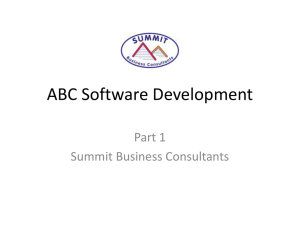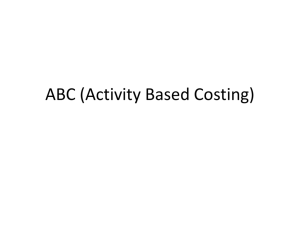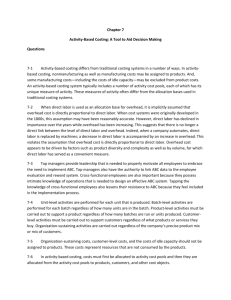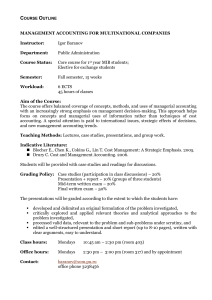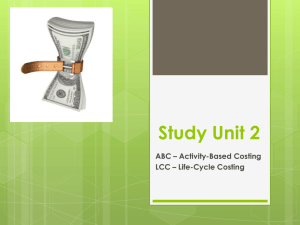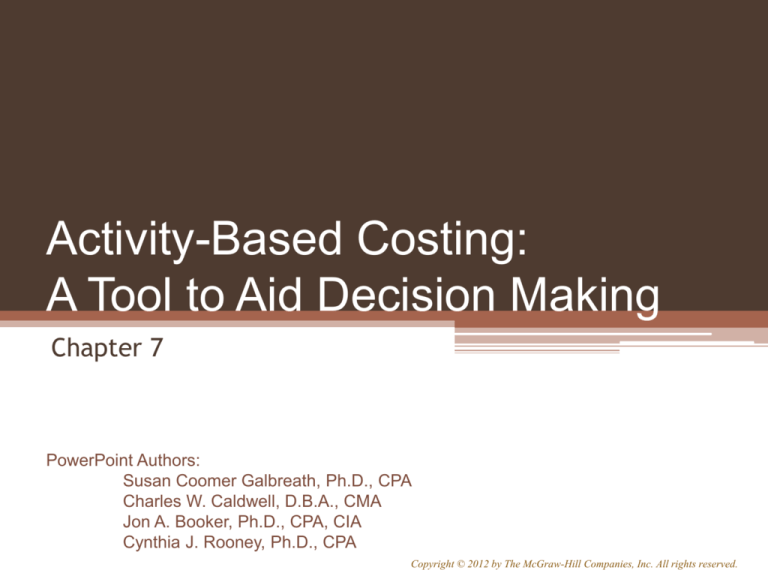
Activity-Based Costing:
A Tool to Aid Decision Making
Chapter 7
PowerPoint Authors:
Susan Coomer Galbreath, Ph.D., CPA
Charles W. Caldwell, D.B.A., CMA
Jon A. Booker, Ph.D., CPA, CIA
Cynthia J. Rooney, Ph.D., CPA
Copyright © 2012 by The McGraw-Hill Companies, Inc. All rights reserved.
7-2
Activity–Based Costing (ABC)
ABC is designed to
provide managers with
cost information for
strategic and other
decisions that
potentially affect
capacity, and therefore,
affect “fixed”
as well as variable
costs.
ABC is a
good supplement
to our traditional
cost system
I agree!
7-3
Learning Objective 1
Understand activitybased costing and how it
differs from a traditional
costing system.
7-4
How Costs are Treated Under
Activity–Based Costing
ABC differs from traditional cost accounting in three ways.
Manufacturing
costs
Nonmanufacturing
costs
Traditional
product costing
ABC
product costing
ABC assigns both types of costs to products.
7-5
How Costs are Treated Under
Activity–Based Costing
ABC differs from traditional cost accounting in three ways.
Traditional
product costing
Nonmanufacturing
costs
Some
All
Manufacturing
costs
ABC
product costing
ABC does not assign all manufacturing costs to products.
7-6
How Costs are Treated Under
Activity–Based Costing
Level of complexity
ABC differs from traditional cost accounting in three ways.
Activity–Based
Costing
Departmental
Overhead
Rates
Plantwide
Overhead
Rate
Number of cost pools
ABC uses more cost pools.
7-7
How Costs are Treated Under
Activity–Based Costing
ABC differs from traditional cost accounting in three ways.
Each ABC cost pool has its
own unique measure of activity.
Traditional cost systems usually rely
on volume measures such as direct labor
hours and/or machine hours to allocate
all overhead costs to products.
ABC uses more cost pools.
7-8
How Costs are Treated Under
Activity–Based Costing
Activity
An event that causes the
consumption of overhead
resources.
Activity
Cost Pool
A “cost bucket” in which
costs related to a single
activity measure are
accumulated.
$$
$
$ $
$
7-9
How Costs are Treated Under
Activity–Based Costing
Activity
Measure
An allocation base
in an activity-based
costing system.
The term cost driver is
also used to refer to
an activity measure.
7-10
How Costs are Treated Under
Activity–Based Costing
Two common types of activity measures:
Transaction
driver
Duration
driver
Simple count
of the number of
times an activity
occurs.
A measure
of the amount
of time needed
for an activity.
7-11
How Costs are Treated Under
Activity–Based Costing
ABC defines
five levels of activity
that largely do not relate
to the volume of units
produced.
Traditional cost systems usually rely on volume
measures such as direct labor hours and/or machine
hours to allocate all overhead costs to products.
7-12
How Costs are Treated Under
Activity–Based Costing
Unit-Level
Activity
Batch-Level
Activity
Manufacturing
companies typically combine
their activities into five
classifications.
Product-Level
Activity
Organizationsustaining
Activity
Customer-Level
Activity
7-13
Characteristics of Successful ABC
Implementations
Strong top
management support
Link to evaluations
and rewards
Cross-functional
involvement
7-14
Classic Brass - An ABC Example
Classic Brass
Income Statement
Year Ended December 31, 2011
Sales . . . . . . . . . . . . . . . . . . . . . . . . . . . . . . .
$3,200,000
Cost of goods sold:
Direct materials . . . . . . . . . . . . . . . . . . . . . . $ 975,000
Direct labor . . . . . . . . . . . . . . . . . . . . . . . . . 351,250
Manufacturing overhead* . . . . . . . . . . . . . . 1,000,000
2,326,250
Gross margin . . . . . . . . . . . . . . . . . . . . . . . . .
873,750
Selling and administrative expenses:
Shipping expenses . . . . . . . . . . . . . . . . . . .
65,000
General administrative expenses . . . . . . . .
510,000
Marketing expenses . . . . . . . . . . . . . . . . . .
300,000
875,000
Net operating loss . . . . . . . . . . . . . . . . . . . . .
$ (1,250)
*The company’s traditional cost system allocates manufacturing overhead to products
using a plantwide overhead rate and machine-hours as the allocation base. Inventory
levels did not change during the year.
7-15
Steps for Implementing Activity-Based Costing:
1. Define activities, activity cost pools, and
activity measures.
2. Assign overhead costs to activity cost pools.
3. Calculate activity rates.
4. Assign overhead costs to cost objects using
the activity rates and activity measures.
5. Prepare management reports.
7-16
Define Activities, Activity Cost
Pools, and Activity Measures
At Classic Brass, the ABC team selected the following
activity cost pools and activity measures:
Activity Cost Pool
Customer orders
Product design
Order size
Customer relations
Other .
Activity Measure
Number of customer orders
Number of product designs
Machine-hours
Number of active customers
Not applicable
7-17
Define Activities, Activity Cost
Pools, and Activity Measures
• Customer Orders - assigned all costs of resources
that are consumed by taking and processing
customer orders.
• Product design- assigned all costs of resources
consumed by customer requested Product design.
• Order Size - assigned all costs of resources
consumed as a consequence of the number of units
produced.
• Customer Relations – assigned all costs associated
with maintaining relations with customers.
• Other – assigned all organization-sustaining costs
and unused capacity costs


